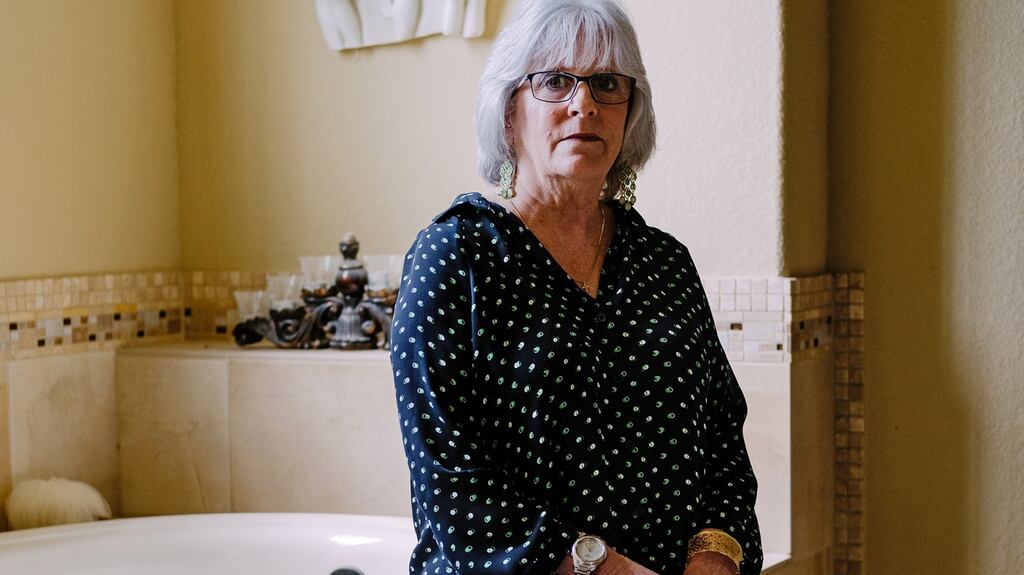When Deborah Huffman went for her annual physical a few years ago, she saw a new doctor who handed her a paper gown, instructing her to leave it open in the back. The doctor returned a few minutes later to find Huffman in the gown, sobbing.
What was wrong?
“I pick at my skin,” Huffman, who is now 65, remembers saying. The doctor peered at Huffman’s back, which was dappled with scabs and open lesions.
It was the first time that Huffman, a retired administrative assistant and former teacher, had told anyone about the habitual behaviour that, since childhood, had made her feel ashamed.
She had long taken pains to conceal the damaged skin on her back, hiding it even from her former husband throughout their 21-year marriage. At the pool, she’d cover up with a T-shirt. During sex, “I wanted it totally dark, and I just wanted to lay flat,” she says. “I never could let myself go.”
Huffman had assumed that the skin-picking behaviour was unique to her. It never occurred to her to seek treatment.
In fact, it’s relatively common. So, too, are a family of related habitual behaviours that include hair pulling, nail biting and cheek biting, among others. While there’s no easy fix, they can typically be treated in a psychotherapy setting by a clinician trained in habit-reversal therapy and other behavioural therapy methods. Yet, we hear little about these conditions, which makes them difficult to identify, treat and study. The shame that affected the individual’s experience is a contributing factor.
These repetitive behaviours typically emerge around the onset of puberty, though they can begin earlier, and are more common in girls and women
Nearly everyone picks at the occasional scab or plucks a stray hair now and then. But mental health professionals make a distinction between those normal grooming acts and a habit that an individual is unable to curb despite attempts to do so, or which causes distress. Habits that meet these criteria are known collectively as body-focused repetitive behaviours. Some patients engage in more than one behaviour.
Habitual skin picking is formally called excoriation disorder (and also known as dermatillomania). These repetitive behaviours typically emerge around the onset of puberty, though they can begin earlier, and are more common in girls and women.
They tend to occur along with mood disorders such as anxiety and depression, or with obsessive-compulsive disorder. Patients report feeling an urge to pick or pull, followed by a physical sensation of relief or gratification while engaging in the behaviour itself.
But the consequences of having pulled or picked repeatedly – bald patches, injured skin – can elicit feelings of self-disgust and embarrassment.
Over time, those feelings might hinder a patient’s ability to form relationships and function out in the world.

Last year, one of Sara Sampaio’s 7.5 million Instagram followers asked about her eyebrow-grooming routine. Sampaio, a 28-year-old Portuguese model who has walked in Victoria’s Secret and couture fashion shows, responded with a series of posts explaining that she struggles with trichotillomania and frequently pulls hair from her brows. (She fills them in with brow pencil.)
The response from fans with similar issues was overwhelming. “One of the main reasons that people don’t talk about it is they’re afraid to be judged,” Sampaio says. “Hearing me talk about it gave them courage to go speak to their family or friends or a doctor.”
At their most severe, the conditions can put patients at medical risk, says Dr Katharine Phillips, professor of psychiatry at Weill Cornell Medical College. For skin pickers, she says, that could mean serious infection or blood-vessel injury. Some hair pullers ingest the hairs they pluck; accumulation of hair in the gastrointestinal tract can cause digestive issues requiring surgery.
For many people with body-focused repetitive behaviours, though, the predominant effects are cosmetic, and the consequences emotional and social.
Mindy Mitchell noticed in August, 2017 that her elder daughter, Alyssa, who was nine, had begun to pull hair from her scalp. Within six months, Alyssa was bald but for a strip along her crown. Mitchell, who is 36, was alarmed but unsure of what to do. Kids at school began to tease Alyssa for her baldness, calling her names such as "cancer girl".
“Her having to explain that 20 times a day is really upsetting,” Mitchell says. She took Alyssa to be fitted for a wig.
When Mitchell eventually searched online, she came across the nonprofit TLC Foundation for Body-Focused Repetitive Behaviours, a patient-advocacy organisation for the disorders. It works to promote awareness of the behaviours so that affected people can better understand their conditions and seek evidence-based treatment, says Jennifer Raikes, its executive director.
The group maintains an online database of clinicians with relevant experience, and convenes an annual conference for patients, family members, clinicians and researchers. Mitchell and Alyssa were among more than 440 attendees at this year's gathering in Virginia, the US, in May. Alyssa befriended other children who came – some of whom also wear wigs. Mitchell left with some recommendations for treatment options for Alyssa close to home.
When Huffman told her doctor that she struggled with skin picking, the doctor recommended she see a psychologist. She found a local therapist skilled in habit-reversal and cognitive-behavioural techniques. After going to weekly sessions for a year, she learned some strategies for resisting the urge to pick, such as noticing when the urge strikes and having fidget toys at the ready. She’s picking much less now, she says, but still feels self-conscious about scarring.
The therapist also told Huffman about the annual TLC Foundation conference, which she attended for the first time in 2017. There, Huffman saw a hotel ballroom full of people who were working to address behaviours like hers. She was moved to tears.
When she returned home, Huffman worked up the nerve to approach her husband. “I have something I want to tell you,” she remembers saying. “I want you to see my back.” – The New York Times











